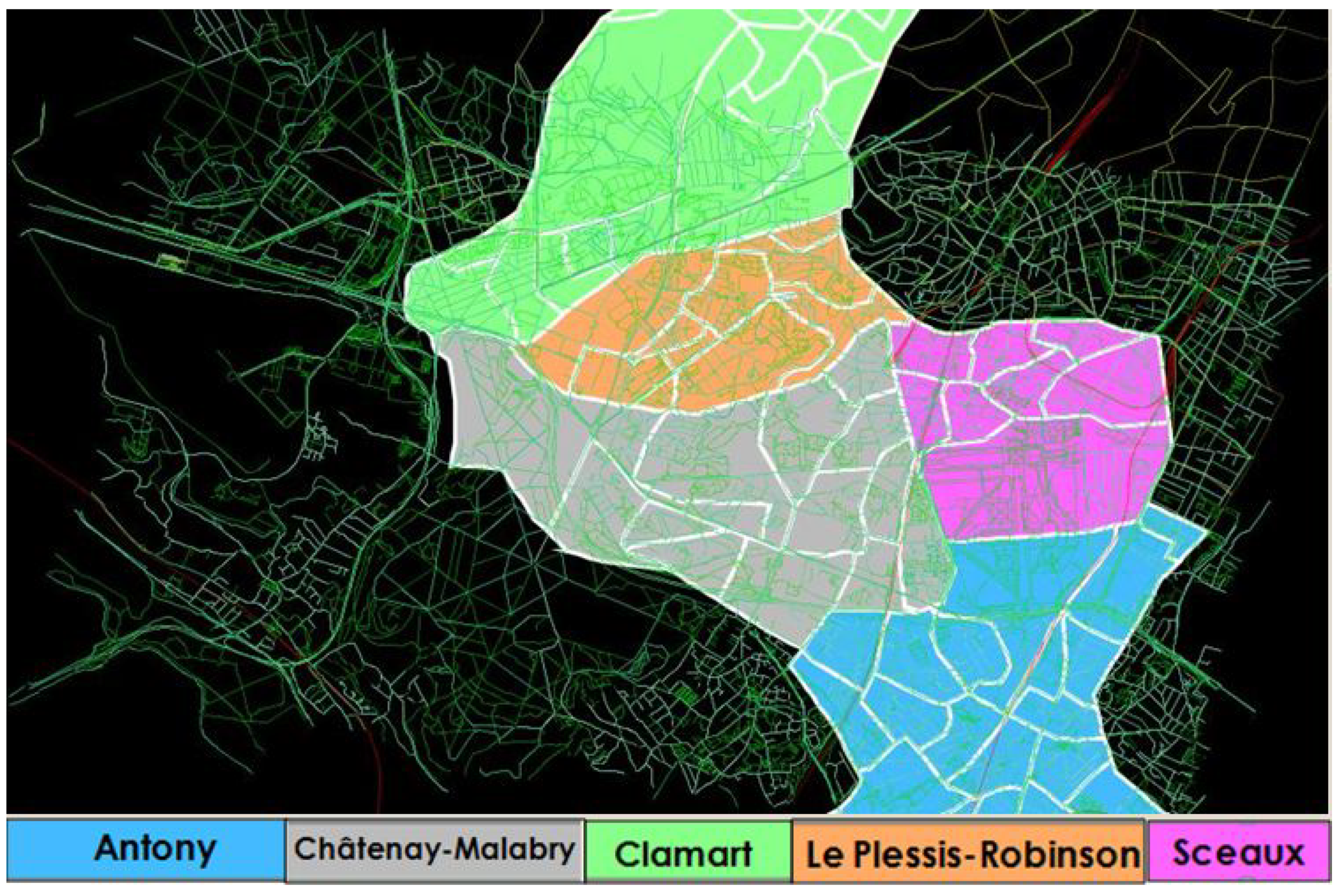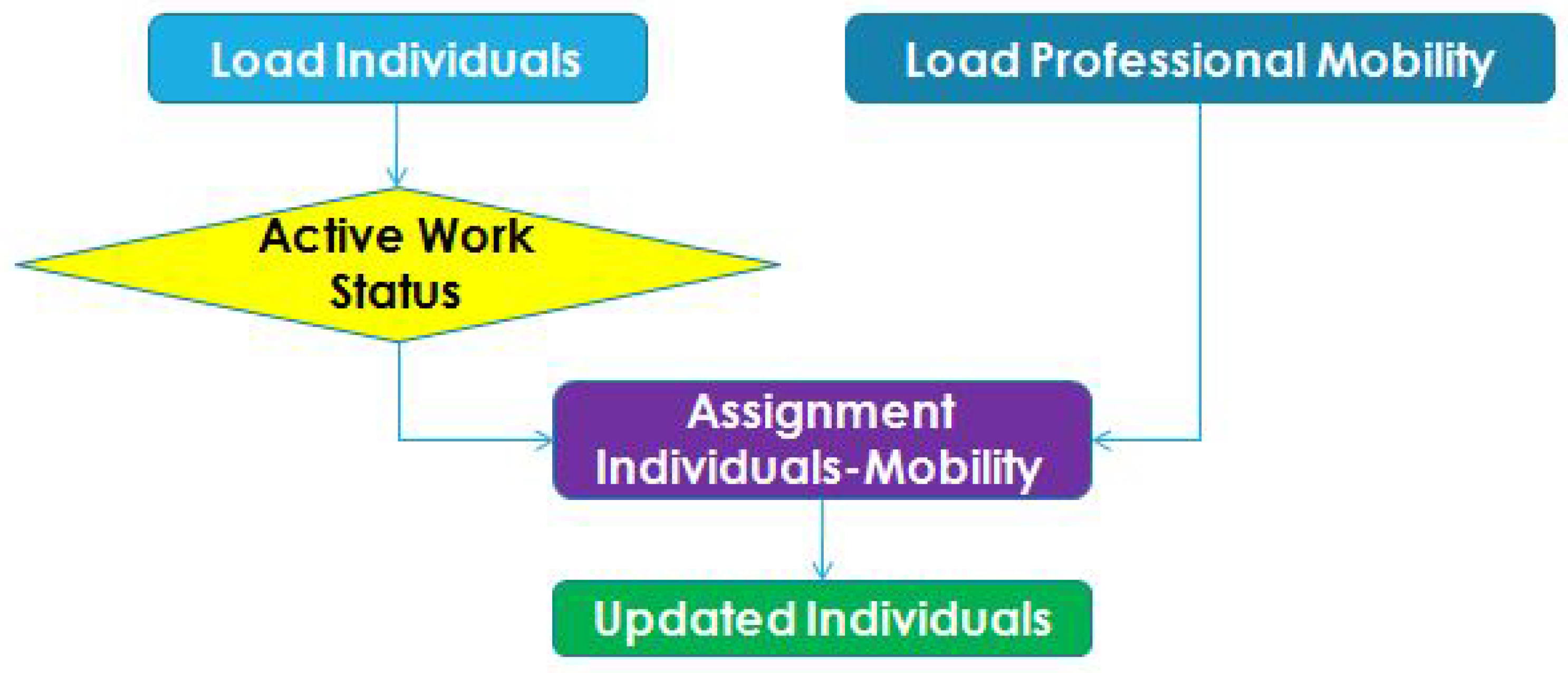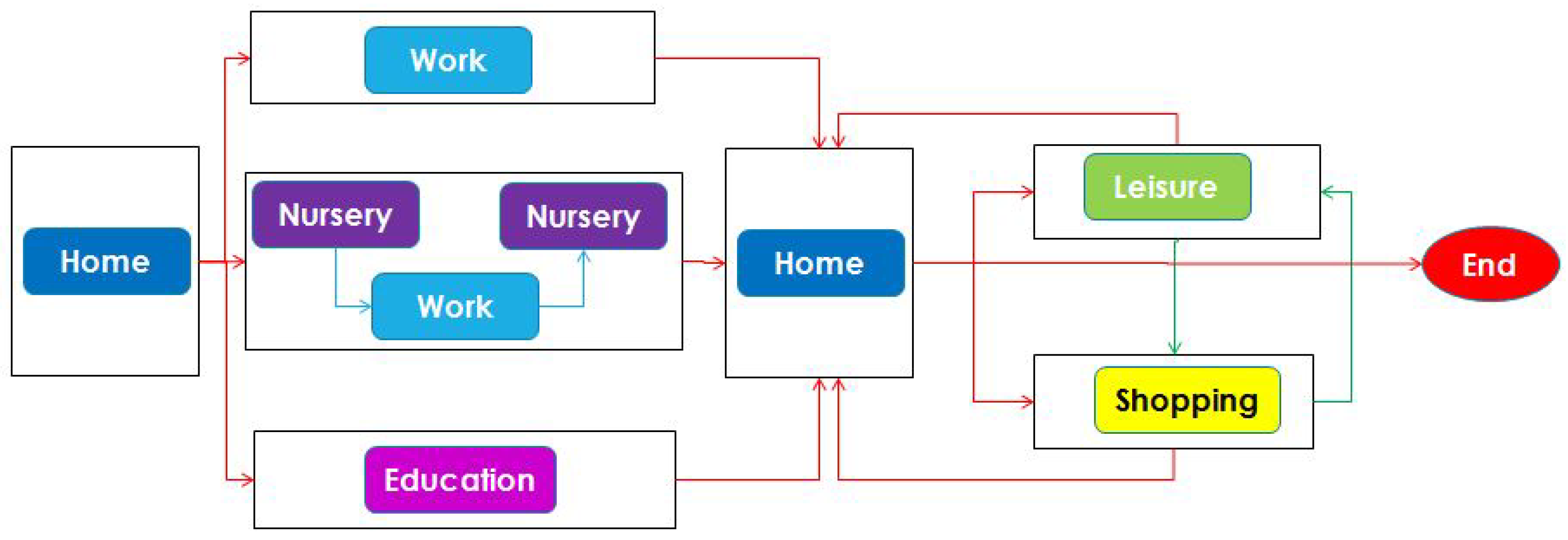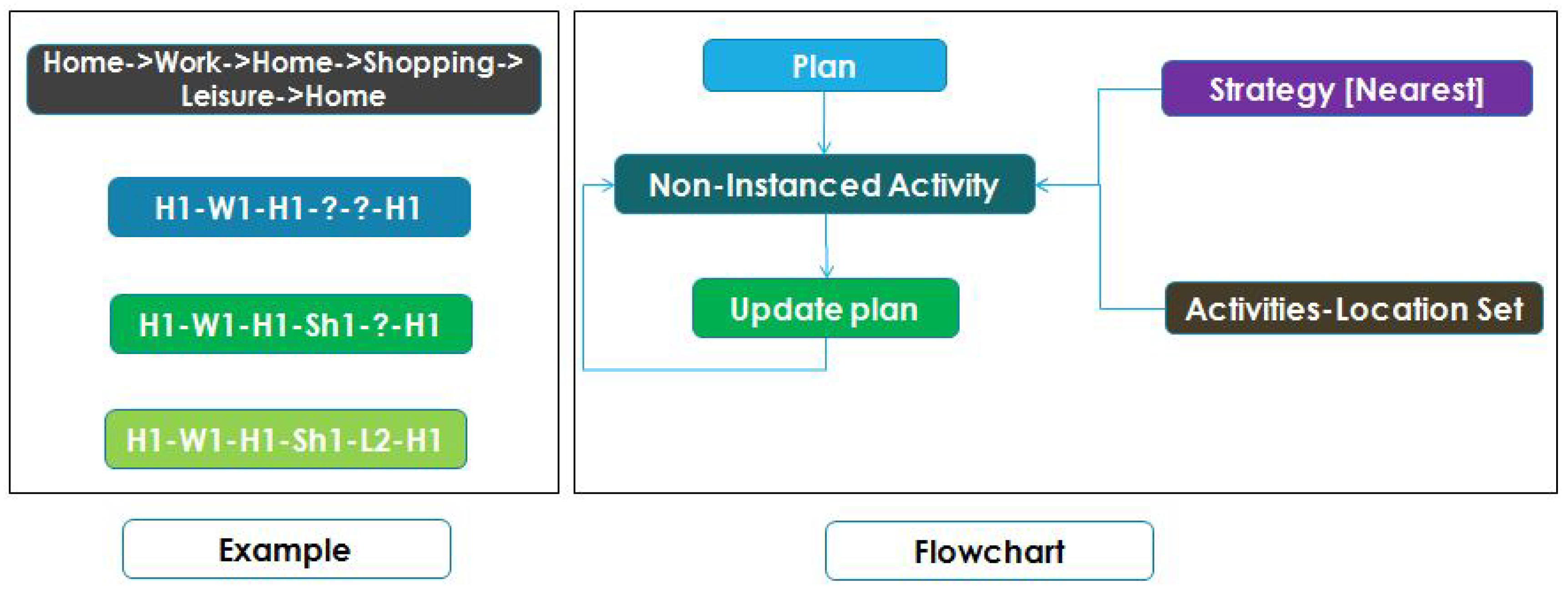Activity-Based Demand Modeling for a Future Urban District
Abstract
1. Introduction
1.1. Activity-Based Models
1.2. Problem Statement and Scope of the Paper
2. Literature Review
3. Case Study
3.1. LaVallée District: A Real-Estate Development
3.2. Travel Demand in the District’s Catchment Area: Overview
- Dynamic travel model around the city of Châtenay-Malabry in a reference situation (baseline scenario without LaVallée): activity plans described from available census data. This article addresses the population generation required to estimate such a travel model.
- Dynamic model of trips predicted inside LaVallée in a projected situation (trips inside LaVallée, mostly with active modes): simulated activity planning from the land use and information on future inhabitants.
- Modeling of urban vitality at the district scale from travels and LaVallée services.
- Global survey data for transport from household census.
- The road network: by default OpenStreetMap (OSM) files.
- Public Transportation (PT) network: the PT (bus/train/tram) stops location and times were extracted manually from [29], the PT routes were generated following the stops-sequence using a shortest path algorithm (e.g., Dijkstra algorithm), compared and corrected manually (if the route is not compatible with the real route). The future tram line (T10 tram line expected for 2023) is also included in the PT network.
4. Generation of the District’s Future Exogenous Demand
4.1. Proposed Methodology
4.1.1. Data Processing
- Load Trips Proportion: this step extracts the activity proportions and trip transportation modes, based on the EGT (Enquête Globale Transport, 2010) [32].
- Load Population Individuals: this step loads the individuals from the INDCVI (Individuals located in the canton or city, 2014) [33]. Only the individuals from the region are selected; the individuals are referenced to the household by household-ID and canton-ID attributes.
- Integrate work-activity from the professional mobility file (Home-Work trips) [34]. It contains mainly the workplace city for each individual. To improve the quality of the selected individuals, we matched the two individuals-sets (population individuals and professional mobility individuals). To do so, we are only interested in the individuals with an active employment status.
- Group individuals by household, based on the household-key (canton-ID, household-ID). Individuals are grouped in households (reconstructing the households), without the need for a SR process.
4.1.2. Activity Plans Generation
- Generate initial plans from households. In this step, we generate initial plans based on the household composition (members), focusing on three home-based tour purposes:
- -
- home/work/home (H-W-H): This tour concerns individuals with an active employment status.
- -
- home/nursery/work/nursery/home (H-N-W-N-H): It is an extension of (H-W-H) tour, related to parents with children (less than 6 years-old).
- -
- home/education/home (H-Ed-H): for students (primary, middle school, high school and university).
- Extend the generated (initial) plans. With the aim to generalize our trip-plans, we decided to integrate new activities (shopping and leisure), based on the EGT [32] statistics.
- Fill Non-Instanced Activities. By extending the trip-plans, several activities may not be instanced (locations missing), which can be the results:
- -
- Individual did not match in (Integrate work-activity step).
- -
- Activity type missing in the BPE [30] file (Load Activities step).
We proposed several instanced methods to fix this issue. We can assign to these (non-instanced) activities either the nearest location (activity place) from home-place, or a random activity in a limited zone (from home-place). - Update workplaces (outside of region). With the aim to integrate the home-work trips for individuals who work outside of region, we decide to replace these workplaces by others on the region-borders (work-borders), then, for each individual, we replace the original workplace, by the work-border place that minimize the distance from home to original place, while passing by the work-border place itself.
- Satisfy the average-trips for the selected region. First, at least one trip for each individual (from home to another activity). Secondly, satisfy the average-trips per user (as in [32]). To deal with these constraints, we added some activities (leisure/shopping) to achieve the average-trips.
4.2. Technical Development
4.2.1. Input Data and Catchment Area Extension
- BPE (Base Permanente des Équipements) intended to provide the level of equipment and services rendered by a territory to the population. This base makes it possible to produce various data about the equipment (indicator of the availability, the density of an item of equipment); all these data being related to a geographical area (IRIS, an equivalent of TAZ Traffic Analysis Zone).
- INDCVI (Individu Localisé au Canton ou VIlle): it is a public census file, it contains an individual-set sorted by the canton Code, each row-data describes an individual (socio-demographic and household characteristics).
- MOB-PRO (Mobilité Professionnelle): bi-localized home-work (trip) data it describing the characteristics of the individual, its household and main residence; the data are sorted by (residence-commune and work-commune).
BPE (Permanent Equipment Base):
- DEPCOM: Department-Municipality code
- DCIRIS: Commune-IRIS-Code.
- TYPEQU: Equipment type.
- LAMBERT-X, LAMBERT-Y: Activity location coordinates.
INDCVI (Individual Located in Canton or City)
MOB-PRO (Professional Mobility)
Study Region: the Catchment Area of LaVallée
4.2.2. Data Processing
Load Activities
- Shopping: small and large areas.
- Education: primary, middle school, high school and university.
- Nursery: kindergarten and creche.
- Work:
- -
- GZ: Business sector.
- -
- IZ: Accommodation and catering sector.
- -
- JZ: Information and communication sector.
- -
- KZ: Financial and insurance activities sector.
- -
- LZ: Real-estate activities sector.
Load Individuals
Integrate Workplace
- Active work status (TACT = “11”).
- Individuals with age equals or more than 18 (AGED > 18).
Assignment Process
- : All individuals are updated (work-activity place assigned).
- : A maximum distance () is achieved ().
- : an attribute.
- S: Comparing attribute-set.
- f: an attribute factor, ().
- F: Attribute factor-set.
- : Individual-set.
- : Individual belongs to ().
- : Mobility individuals.
- p: Mobility person belongs to ().
- M: Assignment maximum allowed distance.
- : Process stop condition ().
- : Hamming distance between two values and .
Group Individuals on Households
4.2.3. Activity Plans Generation
Generate Initial Plans
- Home-Work-Home [H-W-H]: for individuals with TACT = “11”.
- Home-Nursery-Work-Nursery-Home [H-N-W-N-H]: for worker parent with children under 6 (NE6FR > 0 and TACT = “11”). In the parent has not an active work status (TACT ≠ “11”), the trip is replaced by Home-Nursery-Home-Nursery-Home [H-N-H-N-H]. If both parents work, only one will have the nursery-activity.
- Home-Education-Home [H-Ed-H]: this trip concerns the student individuals (ETUD = 1).
Instanced Activities
- Home: we assign to each household a home-place based on its IRIS zone.
- Work: the workplace assigned depends on the type (NA17) and commune (DCLT) of work.
- Shopping, Nursery and Leisure: we assign to them, the nearest activity place from home-place.
- Education: by basing on the individual age (AGED) and student-status (ETUD ), we select the activity type class:
- -
- Primary: .
- -
- Middle School: .
- -
- High School: .
- -
- University: .
As the precedent activities, we assign to this activity, the nearest activity-class place.
Extend Generated Plans
Fill Non-Instanced Activities
Update Workplaces
- Outside region workplaces process: this process concerns individuals who work outside of region (Work-out-Region ‘’), by basing on DCLT-attribute; in this process, we define a set of activity locations on region-borders (Work-Borders ‘’) (see Figure 16), we replace for these individuals, the original workplace () by the closest one on the border () according to Equation (3).
- Inside region workplaces process: we focus on the individuals who work inside the region, this process covers two cases:
- -
- Work type missing in BPE: in this case, we assign randomly a workplace from the same work-commune (of DCLT).
- -
- Work locations missing in municipality: it is case, where the work type (NA) locations are missing in the selected commune (DCLT). To fix this issue, we update the default workplace by the nearest workplace () from home location () and belong to the same type (NA) according to Equation (4).
- : workplace in the region.
- : original workplace (outside of region).
- : work-border place.
- : individual home location.
- : Workplaces outside of region.
- : Workplaces on borders.
- : Workplaces with .
5. Discussion
6. Urban Experimentation
6.1. Model Validation
- At least a trip for each individual: after applying Extension plans process, few individuals still had no trip, potentially: unemployed, retired and house-(wife/husband) individuals (TACT ∈ {12, 21, 24, 25}). We added a secondary activity (shopping or leisure) for individuals with no trip.
- Satisfy average-trip () per user of each city, reported in EGT [32]. For instance, for Antony the potential trips-average (). The synthetic population is fine-tuned as follow: while population average-trips , select randomly an individual (who has less than trips T (), and add to it a secondary activity.
6.2. Composition of the Generated Population
6.3. Experimental Results
6.4. Travels Patterns and Activity Distribution over the Area
- www.youtube.com/watch?v=etR4HRBu0Zo shows an overview of the activity location in the catchment area, including home places of the synthetic population.
- www.youtube.com/watch?v=Du3sYPaiQKA shows the dynamic travel model resulting after dynamic traffic assignment of the travel demand using MATSIM. Some planning tours of individuals are also illustrated.
7. Conclusions
Author Contributions
Funding
Conflicts of Interest
Appendix A




References
- Bonabeau, E. Agent-based modeling: Methods and techniques for simulating human systems. Proc. Natl. Acad. Sci. USA 2002, 99, 7280–7287. [Google Scholar] [CrossRef] [PubMed]
- McNally, M.G. The four step model. Handb. Transp. Model. 2000, 1, 35–41. [Google Scholar]
- Jones, P.E.; Koppelman, F.K. Activity analysis: State-of-the-art and future directions. In Developments in Dynamic and Activity-Based Approaches to Travel Analysis; Gower Publishing: Aldershot, UK, 1990; pp. 34–55. [Google Scholar]
- Smith, L.; Beckman, R.; Baggerly, K. Transims: Transportation Analysis and Simulation System; Technical Report; Los Alamos National Lab.: Los Alamos, NM, USA, 1995. [Google Scholar]
- Arentze, T.; Timmermans, H. Albatross: A Learning Based Transportation Oriented Simulation System; Eirass: Eindhoven, The Netherlands, 2000. [Google Scholar]
- Hörl, S.; Balac, M. Reproducible scenarios for agent-based transport simulation: A case study for Paris and Île-de-France. In Arbeitsberichte Verkehrs-und Raumplanung, 1499; IVT: ETH Zurich, Zurich, Switzerland, 2020. [Google Scholar]
- Dumbliauskas, V.; Grigonis, V. An Empirical Activity Sequence Approach for Travel Behavior Analysis in Vilnius City. Sustainability 2020, 12, 468. [Google Scholar] [CrossRef]
- Moeckel, R.; Spiekermann, K.; Wegener, M. Creating a synthetic population. In Proceedings of the 8th International Conference on Computers in Urban Planning and Urban Management (CUPUM), Sendhai City, Japan, 27–29 May 2003; pp. 1–18. [Google Scholar]
- Huynh, N.N.; Cao, V.; Wickramasuriya Denagamage, R.; Berryman, M.; Perez, P.; Barthelemy, J. An agent based model for the simulation of road traffic and transport demand in a Sydney metropolitan area. Fac. Eng. Inf. Sci. 2014. [Google Scholar] [CrossRef]
- Baghestani, A.; Tayarani, M.; Allahviranloo, M.; Gao, H.O. Evaluating the Traffic and Emissions Impacts of Congestion Pricing in New York City. Sustainability 2020, 12, 3655. [Google Scholar] [CrossRef]
- Yang, Y.; Atkinson, P.; Ettema, D. Individual space-time activity-based modelling of infectious disease transmission within a city. J. R. Soc. Interface 2008, 5, 759–772. [Google Scholar] [CrossRef] [PubMed]
- US Census Bureau, American Community Survey. Summary File Data. Available online: https://www.census.gov/programs-surveys/acs/data/summary-file.2015.html (accessed on 12 April 2020).
- INSEE. National Institute of Statistics and Economic Studies. 2014. Available online: https://insee.fr/fr/accueil (accessed on 6 March 2020).
- Huang, Z.; Williamson, P. A Comparison of Synthetic Reconstruction and Combinatorial Optimisation Approaches to the Creation of Small-Area Microdata; Department of Geography, University of Liverpool: Liverpool, UK, 2001. [Google Scholar]
- Guo, J.Y.; Bhat, C.R. Population synthesis for microsimulating travel behavior. Transp. Res. Rec. 2007, 2014, 92–101. [Google Scholar] [CrossRef]
- US Census Bureau, American Community Survey. 2011–2015 ACS 5-year PUMS Files. 2015. Available online: https://www.census.gov/programs-surveys/acs/data/pums.html (accessed on 7 February 2020).
- Zhu, Y.; Ferreira, J., Jr. Synthetic population generation at disaggregated spatial scales for land use and transportation microsimulation. Transp. Res. Rec. 2014, 2429, 168–177. [Google Scholar] [CrossRef]
- Lim, P.P.; Gargett, D. Population synthesis for travel demand forecasting. In Proceedings of the 36th Australasian Transport Research Forum (ATRF), Brisbane, Australia, 2–4 October 2013. [Google Scholar]
- Metropolis, N. THE BEGINNING of the. Los Alamos Sci. 1987, 15, 125–130. [Google Scholar]
- Williamson, P.; Birkin, M.; Rees, P.H. The estimation of population microdata by using data from small area statistics and samples of anonymised records. Environ. Plan. A 1998, 30, 785–816. [Google Scholar] [CrossRef]
- Ye, X.; Konduri, K.; Pendyala, R.M.; Sana, B.; Waddell, P. A methodology to match distributions of both household and person attributes in the generation of synthetic populations. In Proceedings of the 88th Annual Meeting of the Transportation Research Board, Washington, DC, USA, 11–15 January 2009. [Google Scholar]
- Voas, D.; Williamson, P. An evaluation of the combinatorial optimisation approach to the creation of synthetic microdata. Int. J. Popul. Geogr. 2000, 6, 349–366. [Google Scholar] [CrossRef]
- Stuart, R.; Peter, N. Artificial Intelligence: A Modern Approach. 2020. Available online: http://aima.cs.berkeley.edu/ (accessed on 15 March 2020).
- Ranagalage, M.; Estoque, R.C.; Zhang, X.; Murayama, Y. Spatial changes of urban heat island formation in the Colombo District, Sri Lanka: Implications for sustainability planning. Sustainability 2018, 10, 1367. [Google Scholar] [CrossRef]
- Mauree, D.; Coccolo, S.; Perera, A.T.D.; Nik, V.; Scartezzini, J.L.; Naboni, E. A new framework to evaluate urban design using urban microclimatic modeling in future climatic conditions. Sustainability 2018, 10, 1134. [Google Scholar] [CrossRef]
- Tillie, N.; Borsboom-van Beurden, J.; Doepel, D.; Aarts, M. Exploring a Stakeholder Based Urban Densification and Greening Agenda for Rotterdam Inner City—Accelerating the Transition to a Liveable Low Carbon City. Sustainability 2018, 10, 1927. [Google Scholar] [CrossRef]
- Zhao, Y.; Zhang, G.; Lin, T.; Liu, X.; Liu, J.; Lin, M.; Ye, H.; Kong, L. Towards sustainable urban communities: A composite spatial accessibility assessment for residential suitability based on network big data. Sustainability 2018, 10, 4767. [Google Scholar] [CrossRef]
- Niu, Q.; Wang, Y.; Xia, Y.; Wu, H.; Tang, X. Detailed assessment of the spatial distribution of urban parks according to day and travel mode based on web mapping API: A case study of main parks in Wuhan. Int. J. Environ. Res. Public Health 2018, 15, 1725. [Google Scholar] [CrossRef] [PubMed]
- Real Time Worldwide Public Transit App. Available online: http://https://moovitapp.com/ (accessed on 8 June 2020).
- Base Permanente des Equipements (BPE), Institut National de la Statistique et des études économiques (INSEE). Available online: https://www.insee.fr/fr/statistiques/3568656 (accessed on 21 April 2020).
- Open Street Map. Available online: https://www.openstreetmap.org (accessed on 21 April 2020).
- Enquête Globale Transport—EGT 2010-Île de France Mobilités-OMNIL-DRIEA. Available online: http://www.omnil.fr/spip.php?article88 (accessed on 21 April 2020).
- Individus Localisés au Canton-Ou-Ville, INSEE. 2014. Available online: https://www.insee.fr/fr/statistiques/3141862 (accessed on 21 April 2020).
- Mobilités Professionnelles des Individus, INSEE. 2014. Available online: https://www.insee.fr/fr/statistiques/2866308 (accessed on 22 April 2020).






















| CODGEO | TYPMR | NPERR | NB |
|---|---|---|---|
| Zip Code | Household Type | Household Size | Number of Households |
| 92019 | 31 | 4 | 440 |
| 75015 | 42 | 5 | 62 |
| 77420 | 41 | 3 | 75 |
| Person-Id | AGEREVQ | EMPL | SEX |
|---|---|---|---|
| Age by Range of Five Years | Employment Status | ||
| p1 | 020 | 1 | 2 |
| p2 | 065 | 2 | 1 |
| p3 | 025 | 1 | 2 |
| Step | Description |
|---|---|
| 1 | Load activities, trips proportion. |
| 2 | Load individuals (INDCVI, 2014). |
| - Keep only individuals in selected region. | |
| 3 | Add workplace for individuals. |
| - From the professional mobility file. | |
| 4 | Group individuals by households. |
| 5 | Generate initial plans from household |
| Trip purposes: | |
| - home/work/home. | |
| - home/nursery/work/nursery/home. | |
| - home/education/home. | |
| 6 | Extend the generated (initial) plans. |
| - Add leisure/shopping activities. | |
| 7 | Fill the non-instanced activities. |
| 8 | Update workplaces (outside of region) |
| 9 | Satisfy the average-trips for the selected region |
| Attribute | TYPMR | SEXE | LRPM | TRANS | NPERR | EMPL | VOIT | CS1 |
|---|---|---|---|---|---|---|---|---|
| Factor | +∞ | +∞ | 2.0 | 1.5 | 0.8 | 0.6 | 0.2 | 0.2 |
| EGT Trip | Target Activity | Public Transport (pt) | Walk | Bicycle | Car | All |
|---|---|---|---|---|---|---|
| Home-Shopping | Shopping | 8% | 3% | 63% | 26% | 100% |
| Home-Leisure | Leisure | 21% | 3% | 45% | 31% | 100% |
© 2020 by the authors. Licensee MDPI, Basel, Switzerland. This article is an open access article distributed under the terms and conditions of the Creative Commons Attribution (CC BY) license (http://creativecommons.org/licenses/by/4.0/).
Share and Cite
Delhoum, Y.; Belaroussi, R.; Dupin, F.; Zargayouna, M. Activity-Based Demand Modeling for a Future Urban District. Sustainability 2020, 12, 5821. https://doi.org/10.3390/su12145821
Delhoum Y, Belaroussi R, Dupin F, Zargayouna M. Activity-Based Demand Modeling for a Future Urban District. Sustainability. 2020; 12(14):5821. https://doi.org/10.3390/su12145821
Chicago/Turabian StyleDelhoum, Younes, Rachid Belaroussi, Francis Dupin, and Mahdi Zargayouna. 2020. "Activity-Based Demand Modeling for a Future Urban District" Sustainability 12, no. 14: 5821. https://doi.org/10.3390/su12145821
APA StyleDelhoum, Y., Belaroussi, R., Dupin, F., & Zargayouna, M. (2020). Activity-Based Demand Modeling for a Future Urban District. Sustainability, 12(14), 5821. https://doi.org/10.3390/su12145821





